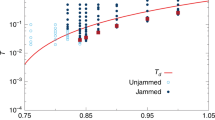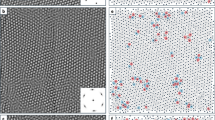Abstract
DESPITE the strong interest in melting over the past 100 years, a general theory for the crystal–liquid transition has not been established1. Lattice-instability models, which are either vibrational2, elastic3, isochoric4, defective5 or entropic6 in nature, all predict a melting point somewhat above the experimentally observed thermodynamic melting temperature, with the ultimate stability limit of a superheated crystal being determined by the equality of crystal and liquid entropies4,6; this forces regular melting to be a first-order transition. Here I present a model of melting that is driven by the incorporation into the lattice of randomly frozenin defects. An isentropic condition limits the stability of the crystal as a function of defect concentration; above the glass transition temperature the crystal melts to a liquid, whereas below it 'melting' produces an amorphous solid. This model yields a generic melting diagram with a tunable parameter (defect concentration) that can characterize the static disorder present in solid-state amorphization7–9, the thermodynamic stability of small clusters10 and nanocrystalline materials11, and the frustration present in spin glasses12. The model is also relevant to glacial13, geological14 and stellar-atmospheric15 melting processes.
This is a preview of subscription content, access via your institution
Access options
Subscribe to this journal
Receive 51 print issues and online access
$199.00 per year
only $3.90 per issue
Buy this article
- Purchase on Springer Link
- Instant access to full article PDF
Prices may be subject to local taxes which are calculated during checkout
Similar content being viewed by others
References
Cahn, R. W. Nature 323, 668–669 (1986).
Lindemann, F. A. Z. Phys. 11, 609–615 (1910).
Born, M. J. chem. Phys. 7, 591–599 (1939).
Tallon, J. L. Nature 342, 658–660 (1989).
Gorecki, T. Scripta metall. 11, 1051–1057 (1977).
Fecht, H. J. & Johnson, W. L. Nature 334, 50–51 (1988).
Johnson, W. L. Progr. Mat. Sci. 30, 81–134 (1986).
Samwer, K. Phys. Rep. 161, 1–41 (1988).
Wolf, D., Okamoto, P. R., Yip, S., Lutsko, J. F. & Kluge, M. J. Mat. Res. 5, 286–301 (1990).
Ajavan, P. M. & Marks, L. D. Phys. Rev. Lett. 60, 585–587 (1988).
Gleiter, H. Prog. Mat. Sci. 33, 223–315 (1989).
LeDoussal, P. & Harris, A. B. Phys. Rev. Lett. 61, 625–629 (1988).
Mishima, O., Calvert, L. D. & Whalley, E. Nature 310, 393–395 (1984).
Richet, P. Nature 331, 56–57 (1988).
Kouchi, A. & Kuroda, T. Nature 344, 134–136 (1990).
Singh, H. B. & Holz, A. Solid State Comm. 45, 985–987 (1983).
Perepezko, J. H. & Paik, J. S. J. non-cryst. Sol. 61 & 62, 113–116 (1984).
Thompson, C. V. & Spaepen, F. Acta metall. 27, 1855–1859 (1979).
Fecht, H. J., Perepezko, J. H., Lee, M. C. & Johnson, W. L. J. appl. Phys. 68, 4494–4502 (1990).
Goodman, D., Cahn, J. W. & Bennett, L. H. Bull. Alloy Phase Diag. 2, 29–35 (1981).
Wollenberger, H. J. in Physical Metallurgy (eds Cahn, R. W. & Haasen, P.) 1139 (Elsevier, Amsterdam, 1983).
Doyama, M. & Koehler, J. S. Acta Metall. 24, 871–879 (1976).
Kauzmann, W. Chem. Rev. 43, 219–256 (1948).
Fecht, H. J., Fu, Z. & Johnson, W. L. Phys. Rev. Lett. 64, 1753–1756 (1990).
Sethna, J. P., Shore, J. D. & Huang, M. Phys. Rev. B44, 4943–4959 (1951).
Fecht, H. J., Desré P. & Johnson, W. L. Phil. Mag. B59, 577–585 (1989).
Highmore, R. J. & Greer, A. L. Nature 339, 363–365 (1989).
Yukalov, V. I. Phys. Rev. B32, 436–446 (1985).
Lifshitz, E. M. & Pitaevski, L. P. Statistical Physics, 3rd edn (Pergamon, Oxford, 1980).
Gorecki, T. Z. Metallkunde 70, 121–126 (1979).
Author information
Authors and Affiliations
Rights and permissions
About this article
Cite this article
Fecht, H. Defect-induced melting and solid-state amorphization. Nature 356, 133–135 (1992). https://doi.org/10.1038/356133a0
Received:
Accepted:
Issue Date:
DOI: https://doi.org/10.1038/356133a0
This article is cited by
-
Pt-induced atomic-level tailoring towards paracrystalline high-entropy alloy
Nature Communications (2023)
-
Electrochemically induced crystalline-to-amorphization transformation in sodium samarium silicate solid electrolyte for long-lasting sodium metal batteries
Nature Communications (2023)
-
Physical properties and structure of mechanically activated solid solution Pb(Zr0.7Ti0.3)O3
Applied Physics A (2022)
-
Influence of structural defects on the physical properties of BiFeO3
Applied Physics A (2022)
-
Mechanisms of Densification and Bonding in the Ultrasonic Consolidation of Aluminum Powder
Metallurgical and Materials Transactions A (2022)
Comments
By submitting a comment you agree to abide by our Terms and Community Guidelines. If you find something abusive or that does not comply with our terms or guidelines please flag it as inappropriate.



